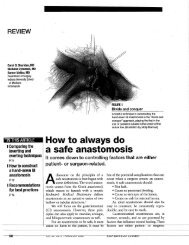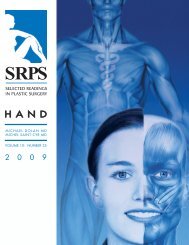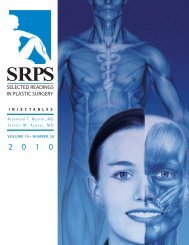Craniofacial Anomalies, Part 2 - Plastic Surgery Internal
Craniofacial Anomalies, Part 2 - Plastic Surgery Internal
Craniofacial Anomalies, Part 2 - Plastic Surgery Internal
Create successful ePaper yourself
Turn your PDF publications into a flip-book with our unique Google optimized e-Paper software.
Approximately 2% of cases of isolated craniosynostosis<br />
are inherited. 154 Cohen, Dauser, and Gorski 155<br />
documented three close relatives with delayed onset<br />
of exorbitism and midfacial retrusion thought to be<br />
consistent with a diagnosis of familial, nonsyndromic<br />
craniosynostosis. In contrast, a hereditary component<br />
has been identified in as many as 50% of<br />
syndromal craniosynostosis patients. 154<br />
The Role of the Dura in Craniosynostosis<br />
In cases of primary craniosynostosis the underlying<br />
dura mater acts locally to supply the overlying<br />
suture with osteogenic growth factors. Opperman in<br />
1993 showed the role of the dura in determining the<br />
fate of suture fusion, 156 and that these dural factors<br />
were soluble. 157 Hobar158,159 noted the importance<br />
of the dura in the regeneration of cranial bones in<br />
infants. Greenwald160,161 went further, finding that<br />
immature dura mater contained a subpopulation of<br />
osteoblast-like cells. Levine162 showed that the region<br />
of the dura was as important as the interaction<br />
between the suture and the dura. The overlying<br />
pericranium does not play a role in suture biology,<br />
according to Opperman. 163 Clearly the dura underlying<br />
the suture drives the timing of closure through<br />
osteoinductive growth factors<br />
Molecular Genetics in Craniosynostosis<br />
Elevated FGF-R2 was identified by Delezoide164 as the first real marker of prechondrogenic condensations.<br />
Mangasarian165 identified a tyrosine for cysteine<br />
substitution on the mutated FGF-R2 that creates<br />
an activated form, resulting in uncontrolled FGF<br />
signaling and premature suture closure.<br />
Most166 and Mehrara167 found that expression<br />
of basic fibroblast growth factor (bFGF) was<br />
increased in the dura beneath the suture prior to<br />
fusion and increased in the osteoblasts at the suture<br />
during fusion. Other growth factors have been<br />
found to be increased in prematurely fusing<br />
sutures: transforming growth factor B (TGF-<br />
B) 166,168–171 and bone morphogenic proteins<br />
(BMPs). 171 Research is now directed at inducing<br />
craniosynostosis in animal models by the application<br />
of exogenous FGFs to confirm their role in<br />
suture closure. 172 Genes whose mutations result<br />
in craniosynostosis syndromes are listed in Table<br />
4. 173,174<br />
SRPS Volume 10, Number 17, <strong>Part</strong> 2<br />
TABLE 4<br />
Genes Bearing Known Mutations<br />
for Craniosynostosis<br />
(Reprinted with permission from Cohen MM Jr: Discussion of<br />
“Differential expression of fibroblast growth factor receptors in<br />
human digital development suggests common pathogenesis in<br />
complex acrosyndactyly and craniosynostosis”, by Britto JA,<br />
Chan JCT, Evans RD, et al. Plast Reconstr Surg 107:1339, 2001.)<br />
In 1993 a mutation in the homeobox gene MSX2<br />
was identified in a single family with autosomal dominant<br />
craniosynostosis, now known as Boston-type<br />
craniosynostosis. 175 Recent evidence suggests that<br />
this mutation may exert its effect through BMP pathways<br />
176,177 and that MSX2 mutations may function<br />
together with FGF-R2. 178<br />
Crouzon syndrome has been extensively studied<br />
genetically and a mapped abnormality is noted on<br />
the long arm of chromosome 10. 179 Further analysis<br />
localized an FGF-R2 genetic mutation within this<br />
chromosome in subjects with Crouzon. 180<br />
In 1994 Muenke and colleagues 181 described a<br />
common mutation in the FGF-R1 gene as the cause<br />
of Pfeiffer’s syndrome. In 1995 Apert and Pfeiffer<br />
syndromes were also found to be related to FGF-R2<br />
mutations. 182–184 Mutations in the FGF-R2 gene now<br />
having been shown to be the cause of Jackson-Weiss<br />
syndrome, Crouzon syndrome, Pfeiffer syndrome, and<br />
Apert syndrome, these conditions should be seen as<br />
defined points along a spectrum of disease (Fig 12).<br />
FGF-R3 mutations are also implicated in isolated<br />
unicoronal craniosynostosis. 185 Current understanding<br />
allows a molecular diagnosis in all phenotypical<br />
cases of bicoronal synostosis. 186 Other genetic mutations<br />
have been associated with synostosis. The<br />
hedgehog family of homologs, including sonic hedgehog,<br />
play a role in vertebral embryogenesis. Recently<br />
15






